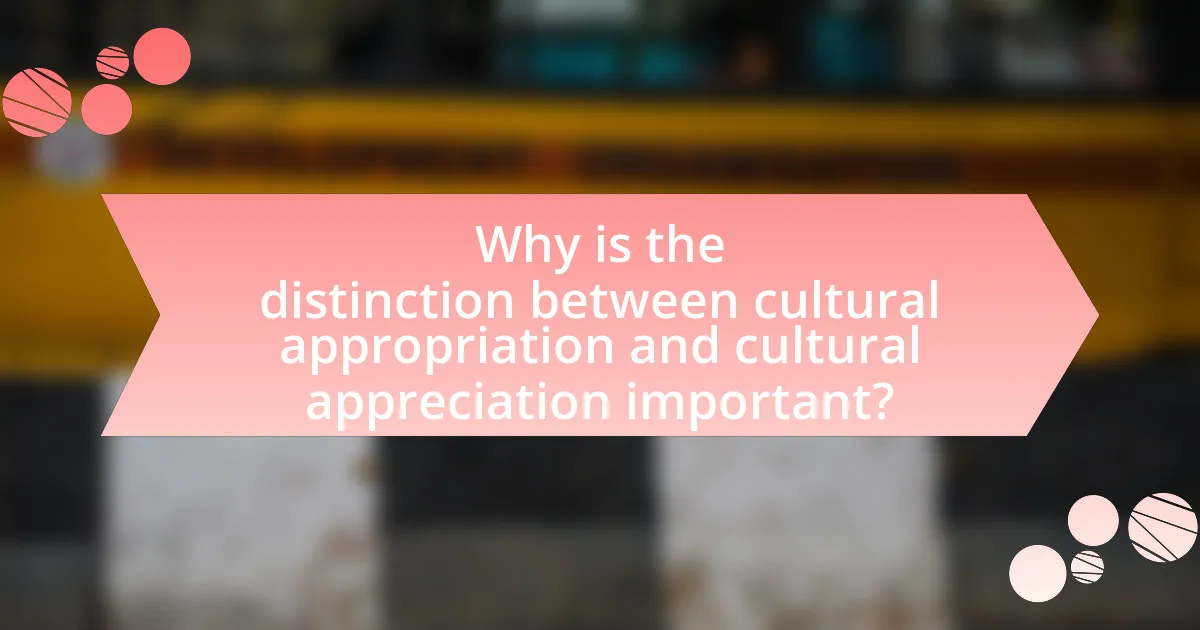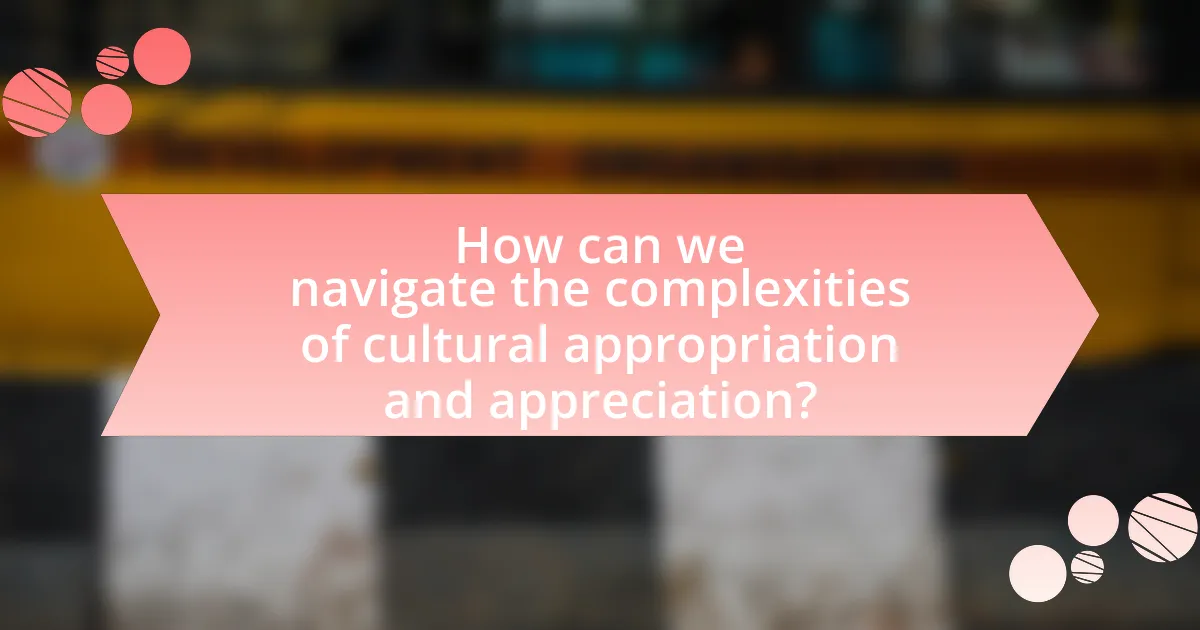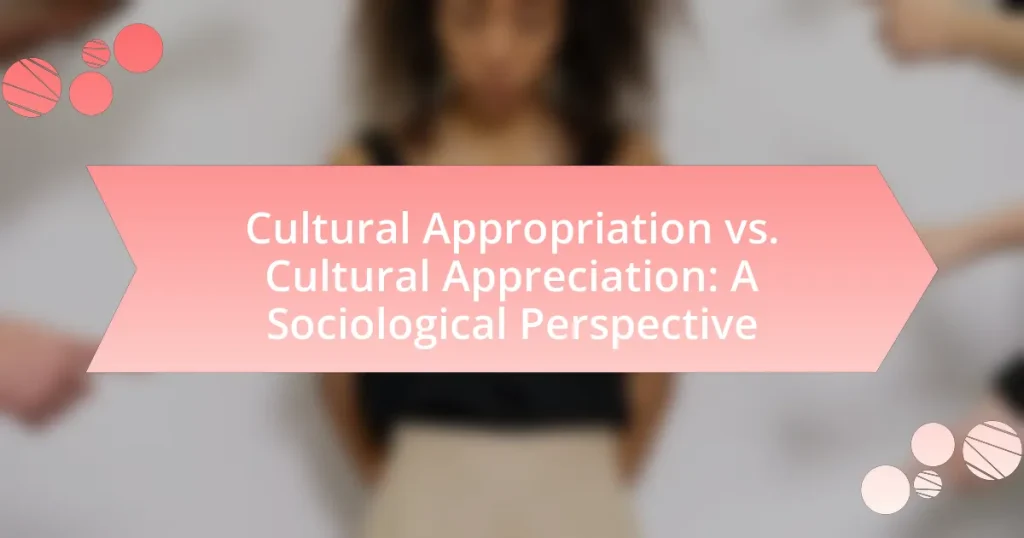Cultural appropriation and cultural appreciation are two distinct concepts that address the interaction between different cultures. Cultural appropriation refers to the unacknowledged or inappropriate adoption of elements from one culture by members of another, often leading to exploitation and disrespect, particularly when a dominant culture appropriates from a marginalized one. In contrast, cultural appreciation involves a respectful understanding and valuing of another culture, emphasizing engagement and acknowledgment of its origins. This article explores the definitions, historical contexts, key characteristics, and social consequences of both concepts, highlighting the importance of consent and power dynamics in cultural interactions. Additionally, it discusses strategies for fostering cultural appreciation while avoiding appropriation, emphasizing the role of education and cultural exchange in promoting mutual respect and understanding.

What is Cultural Appropriation vs. Cultural Appreciation?
Cultural appropriation involves the adoption of elements from one culture by members of another culture, often without permission and typically in a way that disregards the original cultural significance. In contrast, cultural appreciation refers to the respectful understanding and valuing of another culture, often involving engagement and acknowledgment of its origins and meanings. For instance, wearing traditional attire from another culture in a respectful context, such as a cultural exchange, exemplifies appreciation, while using that attire as a costume for entertainment without understanding its significance exemplifies appropriation. This distinction is crucial in discussions about power dynamics and respect in cultural interactions.
How do we define cultural appropriation?
Cultural appropriation is defined as the act of taking or using elements from one culture by members of another culture, often without permission or understanding, and typically in a way that can exploit or disrespect the original culture. This phenomenon is frequently criticized when it involves a dominant culture appropriating aspects of a marginalized culture, leading to issues of power dynamics and representation. For instance, the use of traditional Indigenous headdresses as fashion statements by non-Indigenous individuals exemplifies cultural appropriation, as it disregards the significance and sacredness of these items within their original context.
What are the historical contexts of cultural appropriation?
Cultural appropriation has historical contexts rooted in colonialism, globalization, and power dynamics. Throughout history, dominant cultures have often adopted elements from marginalized cultures, frequently without permission or understanding, leading to exploitation and misrepresentation. For instance, during the colonial era, European powers appropriated indigenous art, clothing, and rituals, stripping them of their original meanings and commodifying them for profit. This pattern continued into the 20th century, where the commercialization of cultural symbols, such as Native American headdresses in fashion, exemplified the ongoing disregard for the significance of these elements to their original cultures. The historical contexts reveal a consistent trend of unequal power relations, where the appropriation of cultural elements often reflects broader social injustices and reinforces stereotypes.
What are the key characteristics of cultural appropriation?
Cultural appropriation is characterized by the adoption of elements from one culture by members of another culture, often without permission or understanding. This practice typically involves a power imbalance, where the dominant culture appropriates aspects of a marginalized culture, leading to exploitation and commodification. Key characteristics include lack of context, where cultural symbols are used superficially; the erasure of the original meaning, which diminishes the significance of cultural practices; and the commercialization of cultural elements, often profiting the appropriating culture while the original culture remains marginalized. Historical examples, such as the use of Native American headdresses in fashion, illustrate these characteristics, as they strip away the cultural significance and context of the original practices.
How do we define cultural appreciation?
Cultural appreciation is defined as the respectful understanding and valuing of a culture that is not one’s own, recognizing its significance, history, and contributions. This concept emphasizes engagement with cultural practices, traditions, and expressions in a manner that honors their origins and context, rather than exploiting or misrepresenting them. For instance, participating in cultural events, learning about cultural histories, and supporting artists from that culture exemplify cultural appreciation. This approach fosters mutual respect and understanding, contrasting sharply with cultural appropriation, which often involves taking elements from a culture without permission or understanding, leading to misrepresentation and disrespect.
What are the historical contexts of cultural appreciation?
Cultural appreciation has historical contexts rooted in colonialism, globalization, and intercultural exchange. During colonial times, dominant cultures often appropriated elements from colonized societies, leading to a complex relationship where appreciation was intertwined with exploitation. The 20th century saw increased globalization, allowing for greater interaction among cultures, which facilitated genuine appreciation but also raised concerns about appropriation. For instance, the Harlem Renaissance in the 1920s exemplified cultural appreciation as African American artists celebrated their heritage, influencing mainstream culture while reclaiming their identity. These historical contexts illustrate how cultural appreciation has evolved, reflecting both positive exchanges and the need for sensitivity towards power dynamics in cultural interactions.
What are the key characteristics of cultural appreciation?
Cultural appreciation is characterized by respect, understanding, and genuine interest in another culture. This involves recognizing the value and significance of cultural practices, traditions, and expressions without exploiting or misrepresenting them. Key aspects include active engagement with the culture, learning from its members, and acknowledging the historical context and contributions of that culture. For instance, participating in cultural events or learning a language demonstrates appreciation rather than appropriation, as it fosters mutual respect and dialogue.
What are the main differences between cultural appropriation and cultural appreciation?
Cultural appropriation involves the unacknowledged or inappropriate adoption of elements from one culture by members of another culture, often without understanding or respecting the original context. In contrast, cultural appreciation refers to the respectful engagement with and understanding of another culture, recognizing its significance and value. The distinction lies in the intent and context; appropriation often exploits cultural symbols for personal gain, while appreciation fosters mutual respect and learning. For example, wearing traditional attire for a cultural event with permission and understanding exemplifies appreciation, whereas using such attire as a costume without context exemplifies appropriation.
How do power dynamics influence cultural appropriation and appreciation?
Power dynamics significantly influence cultural appropriation and appreciation by determining which cultures are able to share their practices and which are exploited. Dominant cultures often appropriate elements from marginalized cultures without permission or understanding, leading to misrepresentation and commodification. For instance, the use of Native American headdresses in fashion by non-Native individuals exemplifies this dynamic, as it disregards the cultural significance and sacredness of the item. Conversely, appreciation occurs when there is mutual respect and acknowledgment of the cultural context, as seen in collaborative art projects that involve the original culture’s members. This distinction highlights how power imbalances can lead to exploitation rather than genuine appreciation, reinforcing systemic inequalities.
What role does consent play in cultural appropriation versus appreciation?
Consent is crucial in distinguishing cultural appropriation from cultural appreciation, as it signifies respect and acknowledgment of the originating culture. In cultural appreciation, individuals engage with another culture’s practices or symbols with permission and understanding, fostering mutual respect. Conversely, cultural appropriation occurs when elements of a culture are used without consent, often leading to exploitation or misrepresentation. For instance, the use of Native American headdresses in fashion without permission disregards the cultural significance and sacredness of these items, exemplifying appropriation. Thus, consent serves as a boundary that defines respectful engagement versus exploitative appropriation.

Why is the distinction between cultural appropriation and cultural appreciation important?
The distinction between cultural appropriation and cultural appreciation is important because it affects power dynamics and respect between cultures. Cultural appropriation involves taking elements from a marginalized culture without permission, often leading to exploitation and reinforcing stereotypes, while cultural appreciation involves understanding and valuing another culture in a respectful manner. For example, when fashion designers use traditional Indigenous patterns without acknowledgment, it exemplifies appropriation, whereas participating in cultural exchange through education and collaboration reflects appreciation. This distinction is crucial for fostering mutual respect and preventing cultural harm, as highlighted in scholarly discussions on cultural sensitivity and ethics in intercultural interactions.
How does cultural appropriation impact marginalized communities?
Cultural appropriation negatively impacts marginalized communities by commodifying their cultural symbols and practices without permission or understanding. This often leads to the erasure of the original cultural context and significance, resulting in a loss of identity and heritage for those communities. For instance, the appropriation of Native American headdresses by non-Indigenous individuals in fashion and festivals disregards the headdress’s sacred meaning and the struggles faced by Indigenous peoples. Additionally, studies indicate that cultural appropriation can perpetuate stereotypes and reinforce power imbalances, as dominant cultures profit from the cultural expressions of marginalized groups while those groups remain marginalized.
What are the social consequences of cultural appropriation?
Cultural appropriation leads to social consequences such as the marginalization of the original culture and the perpetuation of stereotypes. When dominant cultures adopt elements from marginalized cultures without understanding or respecting their significance, it can result in the erasure of the original culture’s identity and history. For instance, the commercialization of Indigenous symbols in fashion often strips them of their cultural meaning, reducing them to mere aesthetic choices. This dynamic reinforces power imbalances and can provoke feelings of anger and resentment among those whose culture is being appropriated, as seen in various protests against fashion brands that exploit cultural motifs without acknowledgment. Additionally, cultural appropriation can hinder genuine cultural exchange, as it often prioritizes profit over authentic representation and understanding.
How can cultural appropriation perpetuate stereotypes?
Cultural appropriation can perpetuate stereotypes by misrepresenting and simplifying the complexities of a culture, often reducing it to caricatures that reinforce existing biases. When dominant cultures adopt elements from marginalized cultures without understanding or respecting their significance, they can create and propagate distorted images that align with stereotypes. For instance, the commercialization of traditional attire or practices can lead to the portrayal of those cultures as exotic or primitive, which reinforces negative perceptions. Research indicates that such representations can influence public attitudes and contribute to systemic discrimination, as seen in studies examining media portrayals of Indigenous peoples, which often rely on stereotypes that misinform societal views.
What are the benefits of cultural appreciation?
Cultural appreciation fosters mutual respect and understanding among diverse communities. By engaging with and valuing different cultures, individuals can enhance their social awareness and empathy, leading to stronger interpersonal relationships. Studies indicate that cultural appreciation can reduce prejudice and promote inclusivity, as seen in research by the American Psychological Association, which highlights that exposure to diverse cultures can diminish stereotypes and biases. Furthermore, cultural appreciation encourages the preservation of cultural heritage, as communities feel valued and supported, leading to a richer, more diverse societal fabric.
How can cultural appreciation foster understanding and respect?
Cultural appreciation fosters understanding and respect by promoting awareness and knowledge of diverse cultural practices and values. When individuals engage in cultural appreciation, they actively seek to learn about and celebrate the traditions, beliefs, and histories of other cultures, which can lead to greater empathy and reduced stereotypes. Research indicates that exposure to different cultures can enhance social cohesion and reduce prejudice, as seen in studies that show intercultural interactions lead to more positive attitudes towards cultural diversity. By valuing and respecting cultural differences, individuals contribute to a more inclusive society where mutual respect is prioritized.
What role does cultural exchange play in appreciation?
Cultural exchange plays a crucial role in fostering appreciation by facilitating mutual understanding and respect among diverse cultures. Through cultural exchange, individuals gain exposure to different traditions, values, and practices, which enhances their ability to appreciate the richness and complexity of other cultures. For instance, programs like cultural festivals and exchange student initiatives have been shown to increase intercultural dialogue and reduce stereotypes, as evidenced by research from the Journal of International and Intercultural Communication, which highlights that participants in such exchanges report higher levels of cultural empathy and appreciation. This process not only enriches personal experiences but also contributes to a more inclusive society that values diversity.

How can we navigate the complexities of cultural appropriation and appreciation?
To navigate the complexities of cultural appropriation and appreciation, individuals must engage in respectful dialogue and seek to understand the cultural significance behind practices and symbols. This involves actively listening to voices from the culture in question, recognizing power dynamics, and acknowledging historical contexts that shape cultural expressions. For instance, when adopting elements from another culture, one should consider whether the act perpetuates stereotypes or commodifies sacred traditions, as seen in the backlash against fashion brands that misrepresent Indigenous designs. By prioritizing education and empathy, individuals can foster genuine appreciation while avoiding appropriation.
What strategies can individuals use to appreciate cultures respectfully?
Individuals can appreciate cultures respectfully by engaging in active listening and learning about the cultural practices, values, and histories of those cultures. This approach fosters understanding and respect, as individuals gain insights into the significance of cultural elements rather than viewing them superficially. For instance, participating in cultural events or workshops led by members of that culture allows for authentic experiences and direct engagement, which enhances appreciation. Additionally, individuals should avoid stereotypes and generalizations, recognizing the diversity within cultures. Research indicates that respectful cultural engagement can lead to greater intercultural understanding and reduced prejudice, as highlighted in studies on cultural competence by researchers such as Darla K. Deardorff.
How can one engage with cultural practices without appropriating them?
To engage with cultural practices without appropriating them, individuals should prioritize understanding and respecting the cultural context and significance of those practices. This involves actively learning about the history, values, and meanings behind the cultural elements one wishes to participate in. For example, participating in a cultural ceremony should be done with permission from community leaders and ideally in collaboration with members of that culture, ensuring that the practice is honored rather than commodified. Engaging in cultural exchange, rather than cultural theft, emphasizes mutual respect and appreciation, which is crucial in avoiding appropriation.
What are some examples of respectful cultural appreciation?
Respectful cultural appreciation includes practices such as participating in cultural festivals, learning and sharing traditional crafts, and studying languages from different cultures. For instance, attending a Diwali celebration with an understanding of its significance fosters respect for Indian culture. Engaging in workshops to learn traditional weaving techniques from Indigenous communities honors their heritage while supporting artisans. Additionally, studying and using a language, like Spanish or Mandarin, in a respectful context demonstrates appreciation for the culture it represents. These actions promote understanding and respect, contrasting with cultural appropriation, which often involves superficial or exploitative use of cultural elements.
What resources are available for understanding cultural dynamics?
Resources available for understanding cultural dynamics include academic journals, books, online courses, and cultural organizations. Academic journals such as “Cultural Sociology” and “Journal of Cross-Cultural Psychology” provide peer-reviewed articles that analyze cultural interactions and dynamics. Books like “Cultural Dynamics: A Critical Introduction” by David Held offer comprehensive insights into the subject. Online platforms such as Coursera and edX offer courses on cultural studies and sociology, facilitating a structured learning experience. Additionally, organizations like the American Sociological Association provide resources and networking opportunities for those interested in cultural dynamics. These resources collectively enhance the understanding of how cultures interact, evolve, and influence one another.
How can education play a role in reducing cultural appropriation?
Education can significantly reduce cultural appropriation by fostering awareness and understanding of cultural contexts. By integrating comprehensive curricula that cover the histories, values, and practices of diverse cultures, educational institutions can equip students with the knowledge necessary to differentiate between appreciation and appropriation. For instance, studies show that when students engage in discussions about cultural sensitivity and the implications of borrowing cultural elements without permission, they are more likely to respect cultural boundaries. This understanding can lead to more informed and respectful interactions with different cultures, ultimately minimizing instances of appropriation.
What are some best practices for promoting cultural sensitivity?
Best practices for promoting cultural sensitivity include educating individuals about diverse cultures, encouraging open dialogue, and fostering inclusive environments. Education can involve workshops or training sessions that highlight cultural histories and practices, which helps to dispel stereotypes and misconceptions. Open dialogue allows individuals to share their experiences and perspectives, creating a space for understanding and empathy. Fostering inclusive environments means implementing policies that respect and celebrate cultural differences, such as recognizing cultural holidays or incorporating diverse voices in decision-making processes. These practices are supported by research indicating that organizations with high cultural sensitivity experience improved teamwork and employee satisfaction, as noted in studies by the American Psychological Association.
